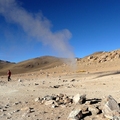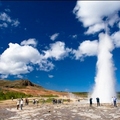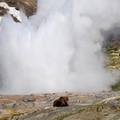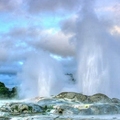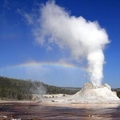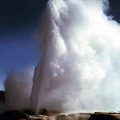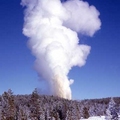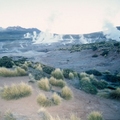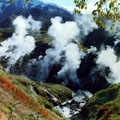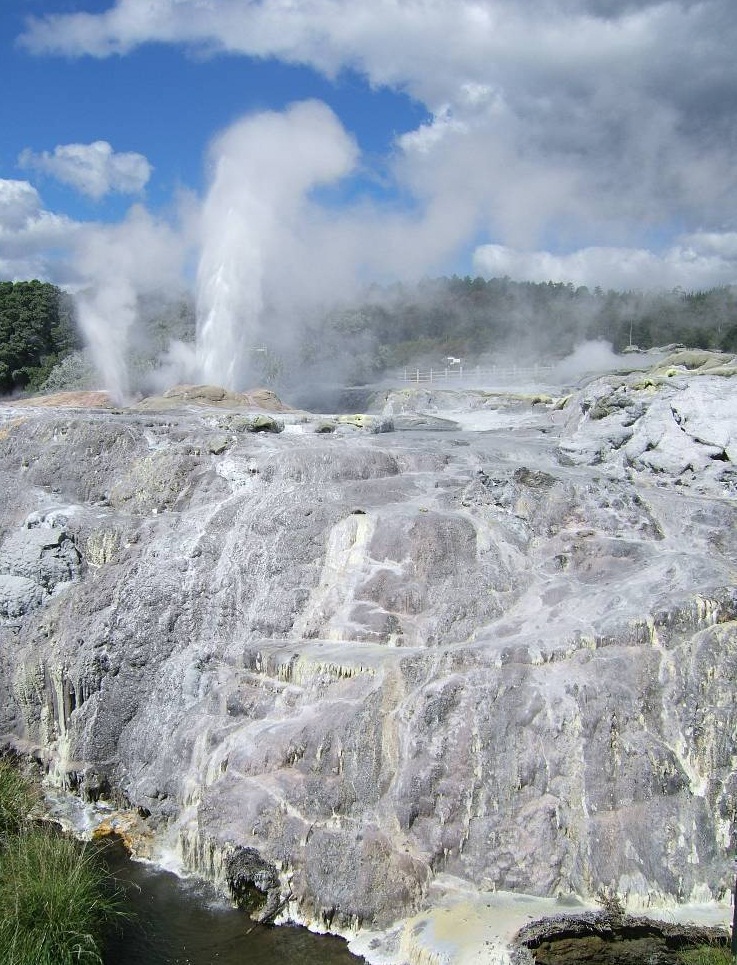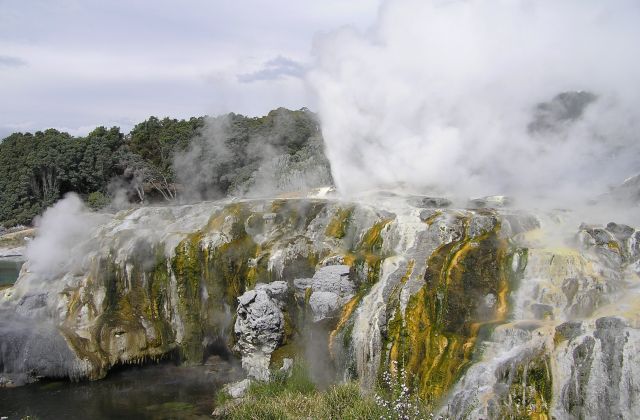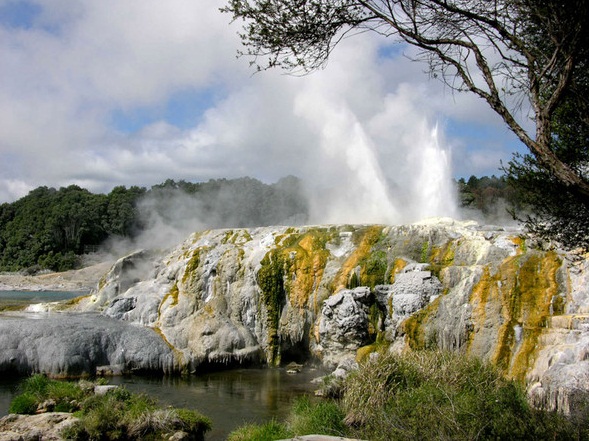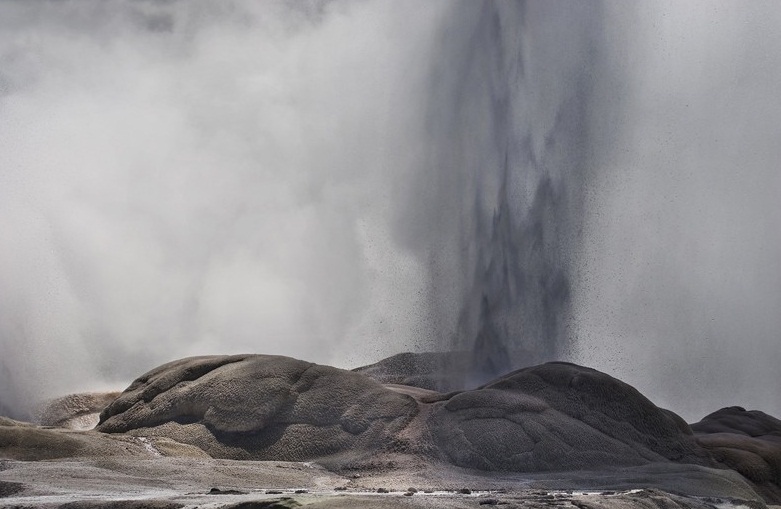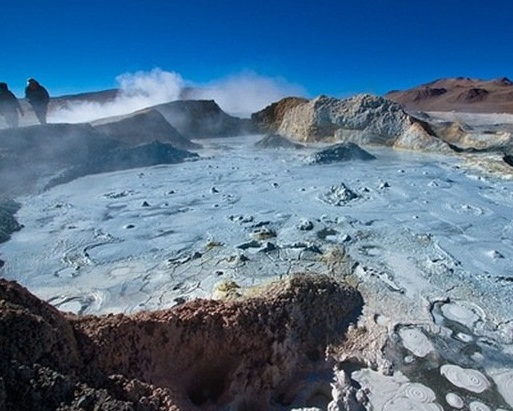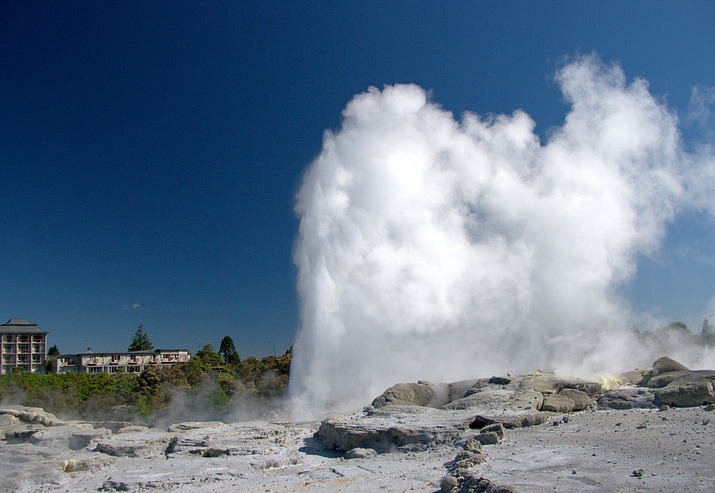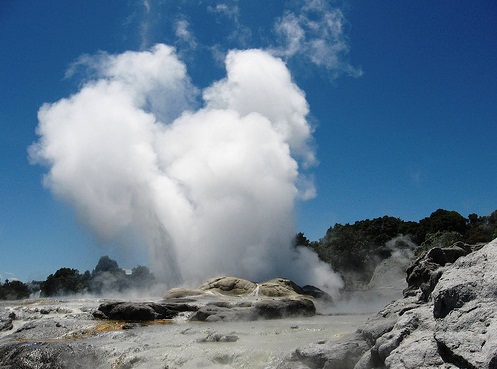World Tourism / The Most Impressive Geysers on the Earth / The Pohutu Geyser, Rotorua, New Zealand
The Pohutu Geyser, Rotorua, New Zealand
A long time ago on the continent that scientists called Godwana, people started to drift to the southeast pieces of sushi. Millions of years they drifted and drifted until it took the places on the Earth's surface, where today we usually look at the maps and continents of Australia, Antarctica and the islands of New Zealand. Better than any other of their co-drift settlements New Zealand’s climate and landscape formed powerful subterranean forces of the Earth. Volcanoes and geothermal sources had arisen here. And the climate and the landscape are magical.
Rotorua-geothermal valley
The most attractive geothermal activity in New Zealand is the region of Rotorua in the North Island. The name “Rotorua” means "big splash" or "explosion." The impression is that there is mud and hot springs, colorful lakes, hissing and pulsating geysers met at every step. The natives of the Maori called this valley Takiva-Vairaki, which translates as "the country of hot water." There is no place not affected by any thermal activity in this valley. In the small town of Rotorua, jets of steam are rising straight out of the cracks in the asphalt. Near the town, as well as on the shores of the Rotorua Lake is a great variety of hot springs.
About Pohutu Geyser
There are sixty-five geysers in this valley, each with its own name, seven of these natural fountains are active. The largest geyser Pohutu, the so-called "splashing geyser” is located here. Pohutu means explosion or big splash. Tourists around the world are witness to the famous geysers of the Rotorua Valley. Of course, Pohutu is the most famous and the largest New Zealand’ s geyser.
The geyser's activity
Every 20 minutes from its 50 cm crater in diameter, a fountain of hot water bursts at a height of 30 meters ( 100 feet). The eruption lasts for an hour, but it happens even longer. Before Pohutu , the smaller geyser located nearby, called "The Prince of Wales Feathers" begins its activity. Sometimes several geysers begin to erupt at the same time and then the viewers see a lot of fountains of varying heightsand sometimes they are "working" in turn, as if trying to outdo each other with the power of the jets and the unusual form of a fountain. Sulfur springs heating the earth and stones are near Pohutu. White siliceous sinters that adorn the openings of natural fountains have yellow hues formed from the dissolved hydrogen sulfide. Unfortunately, not all this fragrant gas is deposited in the form of sulfur emissions, and in Rotorua in the air on the approach to the lake you can feel its particular "flavor".
There is probably no country on this planet that could compare with New Zealand on the number of wonderful, exotic and unique natural phenomena and objects collected by its relatively small area. Volcanoes and geysers, caves and waterfalls, fjords and glaciers, rare reptiles and birds, unique trees and flowers – it is even difficult to enumerate all the wonders of nature, by which a small country located in the "far south" strikes the traveler. But the most important miracle of New Zealand is the Rotorua famous valley, which each visitor in New Zealand is committed to visit.
Even the New Zealanders do not pass by this amazing nature outlook which steals their attention. Located in the heart of Rotorua, North Island of New Zealand's volcanic plateau, the Maori - inhabitants of this ancient island - called the valley-Takiva Vaiariki, which means " The Country of hot water." Plan yourself a visit and do not miss the opportunity to have an unforgettable travel.
Others from The Most Impressive Geysers on the Earth
Geysers are one of the manifestations of later stages of volcanism , and common areas of modern volcanic activity provided by hydrogeological conditions.
Being an intermittent hot water spring and vapor, volcanic, throwing water at regular intervals, to the sea lifting time form of a column, a geyser occurs if the activity of a volcano is at a late stage.
Large assets of geysers in the world are few , but they are of a rare beauty and fascination.
They are a pride and remarkable natural phenomena for the states where they are situated .
No matter what shape, cone-like or like fountains, geysers are rare as they need an almost perfect balance of heat and water conditions and the right rock and channeling.
Best spots of geysers in the world There are few best spots of geysers in the world.
There are only about a thousand geysers in the world situated on some major geothermal areas with geysers force on the Earth: Yellowstone Plateau in the U.
S.
A.
(where it is concentrated about half of all existing geysers), Iceland, New Zeeland( 58 geysers), Kamchatka, Chile, Papua New Guinea ( 38 active geysers), Indonesia( Sumatra Island – 17 geysers), Eastern Africa ( 6 geysers), China ( 10 geysers), Japan ( 4 geysers), Ethiopia and Kenya( very few).
Europeans first learned about the Icelandic geysers in the thirteenth century.
Yellowstone geysers were far from the civilized world until of the first decade of the nineteenth century.
John Colter ‘s stories were perceived as nonsense for too long time.
It took more than fifty years, unless specific expedition with the participation of artists and photographers convinced people of the existence of the world's largest geyser fields in the super-giant caldera of the dormant.
In 1872, Yellowstone geysers were under the protection of the world's first national park.
In 1850, a missionary from R.
Taylor became aware of the geysers in New Zealand.
It was only in 1941 that is only recently in historical terms, has been committed by one of the last great geographical discoveries on the planet.
Thegeologist T.
Ustinova and the conductor Alexander Krupenin, apparently, were the first humans to set foot on the shore of the river called Geyser.
What threatens the geysers? How long do they live? In some parts of the world geothermal geysers are simply former constructions.
In the 19th century , New Zealand North Island had five major geyser fields, which erupted about 220 geysers, now it has only 58 geysers, some of them quite small.
The reasons for the disappearance of New Zealand's geysers are different : natural disasters (volcanic eruption of Tarawera, changes on the groundwater levels), the drilling for the construction of thermal power plants, flooding during the construction of hydroelectric power.
The most powerful geyser on the Earth , Waimangu existed in New Zealand from 1899 to 1904.
With each eruption, it threw about 800 tons of water and trapped many jet stones raised by half a kilometer high.
There are even cases of death, found themselves too close to the erupting from the giant.
But Waimangu stopped working due to the lower water levels in the nearby lake.
Geysers are valuable destinations in the world.
A fascinating circuit where you can live unforgettable moments is visiting spectacular attractions such as the mysterious geysers.
They offer fascinating landscapes where majestic volcanoes and impressive lava formations are found together.
If you are a geyser fan, we offer a selection of the most beautiful and largest geysers in the world.

